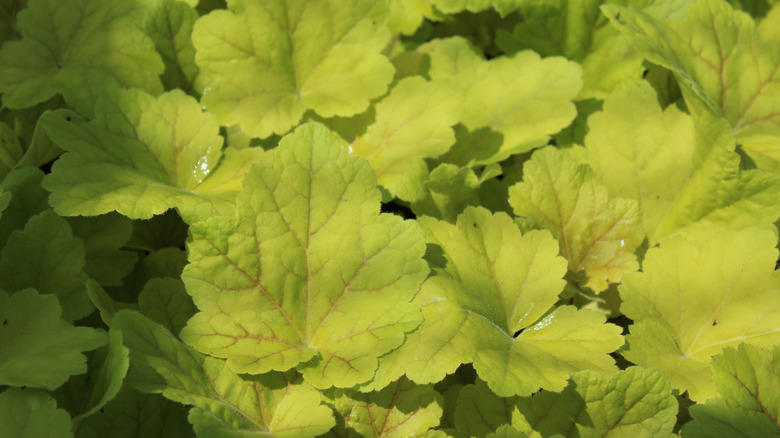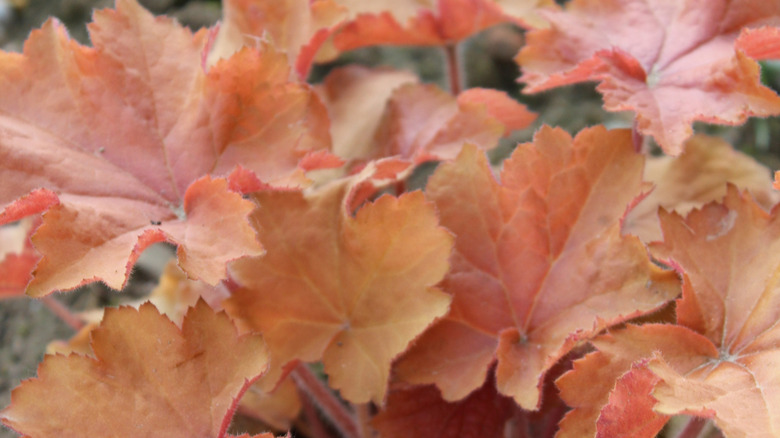13 Striking Varieties Of Coral Bells You Could Be Growing In Your Garden
Coral bells (Heuchera) have always been one of my favorite perennials to recommend as a professional gardener. They are robust, deer-resistant plants, hardy in USDA zones 4 through 9, and provide a long season of interest in the garden. Coral bells are happiest in partial sun or dappled shade. They increase in size each year and are easy to divide. The most appealing aspect of these colorful garden plants is their shapely foliage that comes in many hues, and there are many striking varieties available.
The common name "coral bells" refers to the delicate pink bell-shaped flowers that grow on tall stems above green leaves, blooming from late spring through midsummer, and attracting many pollinators. But newer heuchera hybrids are available in a rainbow of foliage colors, mostly with less showy flowers, though some newer varieties have gorgeous pink or red blooms. The leaves vary in shape, too: some have rounded and scalloped edges, and some have more pointed edges like grape leaves. They add lovely color and texture to the shade garden and provide intriguing foliage colors to sunny beds or tucked among flowering plants and shrubs.
Heuchera plants need deadheading occasionally to remove dead or faded leaves: you can clean them up in early spring and again in late summer to refresh them. Otherwise, these are very low-maintenance perennials. They prefer a well-drained, slightly acidic, loamy soil and like a moderate amount of water. They don't mind being moved, but the best time to relocate them is in spring or fall; otherwise, the leaves might get a bit droopy, but you can trim them, and new growth will soon appear.
'Cherry Cola'
Some of the most popular coral bells are the varieties with red leaves, because they provide glorious warm foliage colors all season long, not just in autumn when most red leaves appear. As the leaves of coral bells mature through the season, they often take on many subtle hues and tones, and this is definitely the case with 'Cherry Cola,' a handsome cultivar with leaves of dusky red, orange, and burgundy. This plant also has gorgeous red-orange flowers that appear in late spring and last for weeks.
'Electra'
I'm a huge fan of chartreuse foliage in the garden: it stands out among other shades of green and also combines beautifully with other colors like reds, pinks, oranges, and blues. The veining of the 'Electra' heuchera plant has a subtle reddish-orange hue that offers a delicate but gorgeous effect in the garden. I like to pair these with a 'Fire Island' hosta (chartreuse leaves with dark red stems) and a dark red heuchera like 'Fire Chief' or 'Fire Alarm' for stunning foliage contrast.
'Black Forest Cake'
This striking heuchera cultivar has deep burgundy-red leaves topped with cherry-red flowers on dark red stems: a delightful and delicious color trifecta! 'Black Forest Cake' is a showstopper in the garden all season long. Once the flowers are done, you still have that boldly hued foliage to draw the eye. I find these darkly hued heucheras can be a bit sensitive to bright sun, so I try to locate them where they get some morning sun, but not late afternoon sun, to protect the leaves from possible scorching during a heat wave.
'Marmalade'
The frilly, wavy leaves of 'Marmalade' are wonderfully colorful, with hues of orange, peach, pink, and olive green, and even an occasional touch of purple. The flowers are small, dainty, and white, not showy but a nice accent to the bold foliage with their slender red stems. This one grows about 10 inches high (minus the flower stalks) but makes a big statement with its gorgeous colors and texture.
'Northern Exposure'
There have been many new coral bell plants with silver foliage introduced in recent years, and this is proving to be a popular color in these versatile perennials. There's 'Silver Gumdrop' (with silvery-pink leaves and pink flowers), 'Stainless Steel' (pale silvery-grey leaves and pale pink flowers), and 'Prom Dress' (silvery-purple grapeleaf-shaped foliage), to name only three of many. 'Northern Exposure' has gorgeous pale silvery leaves with charcoal veins and purple undersides. Pale pink flowers atop burgundy stems, lending intriguing color to the border.
'Paris'
This sprightly cultivar has the look of a classic heuchera, with its bright pink flowers and handsome veined leaves of light green. The flowers put on a lovely show, so place this one at the front of the border to show off these bright blooms. But once the flowers have faded, 'Paris' still offers gorgeous color: pale mint green leaves with dark green veins and a silvery sheen that seems to glow.
'Caramel'
I love this variety for its warm, soft foliage colors that look great all season. It's lovely next to blue and purple flowering plants in summer (like perennial geraniums and phlox) and fall (like perennial ageratum or low-growing asters like 'Woods Blue') for a great contrast with the orange leaves. 'Caramel' also makes a wonderful accent to peach and orange mums in autumn, like 'Pat Lehman' (soft peach), 'Coppersmith' (rich orange), 'Chiffon' (cream touched with pink and yellow), and 'Whippoorwill' (peach and dusty rose).
'Plum Pudding'
This whimsically named cultivar has rich tones of purple, plum, and brown, with dark veining that shows off the subtle colors of the intricately shaped leaves. It's a petite cultivar that gets sprays of tiny white flowers with pink accents. 'Plum Pudding' lends vibrant texture to the garden, providing rich contrasting color to green plants like hostas and sedums, and making a great companion color to yellow, blue, pink, or orange flowers.
'Dale's Strain'
This one is such a strong grower in the garden! It's robust and increases in size quickly, so I divide mine every other year. The flowers are not showy: the tall stems have green buds with a feathery texture, and small leaves often grow on the stems too. I usually cut these stems off after a few weeks to let the attractive foliage take center stage: pale green leaves with deep burgundy veining make 'Dale's Strain' a gorgeous choice for anywhere in the garden, and it tolerates sun fairly well without fading.
'Pink Panther'
With its lavender, plum, and purple leaves, plus dark green veining and silvery-pink patina, the subtle hues of 'Pink Panther' add a beautiful cloud of color to the dappled shade garden, and, happily, it also has pale pink flowers! This one holds its color all season and can look great with blue and purple flowers or with pale pink or white-flowering plants for a cool-toned, soft look. I love this one for a pop of color in containers, too, when designing larger arrangements.
'Tiramisu'
This is one of my favorites of the warm-colored coral bells: the lime-green leaves have prominent burnt orange veining that provides knockout color in the garden. As the season progresses, the centers of the leaves often take on a rosy glow of peach, pink, or orange: 'Tiramisu' is really an attention-getter. Try it near yellow, pink, or orange flowers for a vivid patch of color, or liven up the shade garden by placing this bold cultivar among your hostas and astilbes.
'Palace Purple'
This richly hued cultivar has deep burgundy leaves with hues of chocolate brown, and shiny textured foliage that catches the light beautifully. As the foliage matures, it takes on tints of plum, olive green, bronze, and even a bit of dusty pink. The depth of colors makes 'Palace Purple' a great choice for autumn display containers, and it holds its own practically anywhere in the flower bed, especially near blue-toned hostas and sedums (and it straddles that dappled shade space between these shade- and sun-loving plants).
'Paprika'
With lovely shades of peach, orange, coral, red, and vermilion, and touches of olive green, this standout specimen also has prominent veining on the leaves that makes the foliage very showy. Like other orange-hued coral bells, the leaves of 'Paprika' will sometimes turn lighter in the heat of the summer sun, then show deeper colors again once autumn arrives. This cultivar provides stunning color all season long, with its most intense hues of rich orange and red in September and October.













